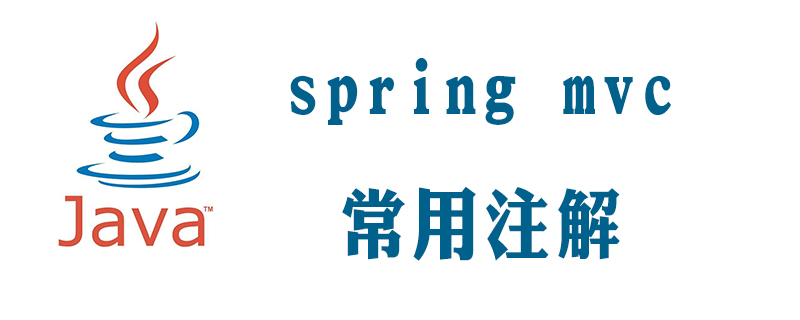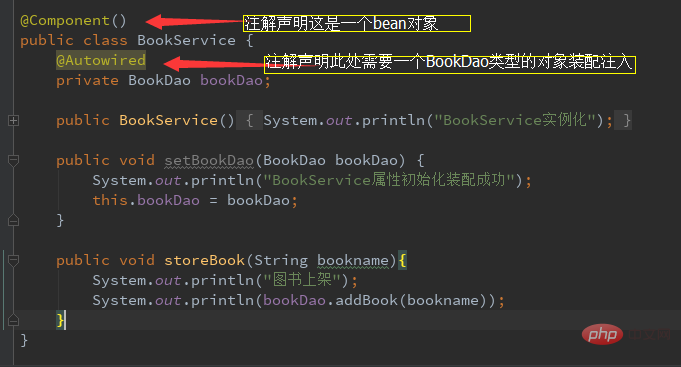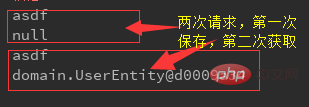

Recommended tutorial: Spring Tutorial
##1. Component-type annotations:
1. @Component Add the @Component annotation before the class definition, and it will be Spring Container identification and conversion to beans.
2. @Repository annotates the Dao implementation class (special @Component)
3. @Service is used to annotate the business logic layer, (special @Component)
4. @Controller is used to annotate the control layer, ( Special @Component)
The above four annotations are all annotated on the class. The annotated class will be initialized as a bean by spring and then managed uniformly.

## 2. Request and parameter type annotations:
1. @RequestMapping: used to process request address mapping, which can be applied to classes and methods.
Value: Define the mapping address of the request requestMethod: Define the method of request address request, including [GET , POST, HEAD, OPTIONS, PUT, PATCH, DELETE, TRACE.] The get request is accepted by default. If the request method is different from the defined method, the request will not succeed.
Params: Define the parameter values that must be included in the request request.
Headers: Define that the request request must contain certain specified request headers, such as: RequestMapping(value = "/something", headers = "content-type=text/*" ) indicates that the request must contain the Content-type header of "text/html", "text/plain" to be a matching request.
●consumes: Define the type of content requested to be submitted.
●produces: Specify the content type to be returned. Only when the (Accept) type in the request header contains the specified type will it be returned
@RequestMapping(value="/requestTest.do",params = {"name=sdf"},headers = {"Accept-Encoding=gzip, deflate, br"},method = RequestMethod.GET)
public String getIndex(){
System.out.println("请求成功");
return "index";
}

2.@RequestParam: used to get the value of the incoming parameter
Value: the name of the parameter
required: definition Whether the incoming parameter is required, the default is true, (similar to the params attribute of @RequestMapping)
@RequestMapping("/requestParams1.do")
public String requestParams1(@RequestParam(required = false) String name){
System.out.println("name = "+name);
return "index";
}
@RequestMapping("/requestParams2.do")
public String requestParams2(@RequestParam(value = "name",required = false) String names){
System.out.println("name = "+names);
return "index";
}##3.@PathViriable: used to define path parameter values
●value: the name of the parameter
●required: defines whether the incoming parameter is a required value@RequestMapping("/{myname}/pathVariable2.do") public String pathVariable2(@PathVariable(value = "myname") String name){
System.out.println("myname = "+name); return "index";
}This path declares {myname} as a path parameter, then this path will be Any value, @PathVariable will be able to get the value of the path based on value.
@RequestMapping("/{myname}/pathVariable2.do")
@ResponseBody
public String pathVariable2(@PathVariable(value = "myname") String name){
System.out.println("myname = "+name);
return "index";
}

## It returns not a page, but the string " index" is printed directly on the page, which is actually similar to the following code. 5、@CookieValue:用于获取请求的Cookie值 6、@ModelAttribute: 用于把参数保存到model中,可以注解方法或参数,注解在方法上的时候,该方法将在处理器方法执行之前执行,然后把返回的对象存放在 session(前提时要有@SessionAttributes注解) 或模型属性中,@ModelAttribute(“attributeName”) 在标记方法的时候指定,若未指定,则使用返回类型的类名称(首字母小写)作为属性名称。 如上代码中,使用了@ModelAttribute("user")注解,在执行控制器前执行,然后将生成一个名称为user的model数据,在控制器中我们通过注解在参数上的@ModelAttribute获取参数,然后将model应用到控制器中,在jsp页面中我们同样可以使用它, 7、@SessionAttributes 默认情况下Spring MVC将模型中的数据存储到request域中。当一个请求结束后,数据就失效了。如果要跨页面使用。那么需要使用到session。而@SessionAttributes注解就可以使得模型中的数据存储一份到session域中。配合@ModelAttribute("user")使用的时候,会将对应的名称的model值存到session中, 结合上一个例子的代码,加了@SessionAttributes注解,然后请求了两次,第一次session中不存在属性名为user的值,第二次请求的时候发现session中又有了,这是因为,这是因为第一次请求时,model数据还未保存到session中请求结束返回的时候才保存,在第二次请求的时候已经可以获取上一次的model了 注意:@ModelAttribute("user") UserEntity user获取注解内容的时候,会先查询session中是否有对应的属性值,没有才去查询Model。PrintWriter out = resp.getWriter();
out.print("index");
out.flush(); @RequestMapping("/requestParams.do")
public String requestParams(@CookieValue("JSESSIONID") String cookie){
return "index";
}@ModelAttribute("user")
public UserEntity getUser(){
UserEntity userEntityr = new UserEntity();
userEntityr.setUsername("asdf");
return userEntityr;
}
@RequestMapping("/modelTest.do")
public String getUsers(@ModelAttribute("user") UserEntity user){
System.out.println(user.getUsername());
return "/index";
} <body>
${user.username}
</body>@Controller
@RequestMapping("/test")
@SessionAttributes(value = {"user","test1"})
public class LoginController{
@ModelAttribute("user")
public UserEntity getUser(){
UserEntity userEntityr = new UserEntity();
userEntityr.setUsername("asdf");
return userEntityr;
}
@RequestMapping("/modelTest.do")
public String getUsers(@ModelAttribute("user") UserEntity user ,HttpSession session){
System.out.println(user.getUsername());
System.out.println(session.getAttribute("user"));
return "/index";
}
}
The above is the detailed content of 5 commonly used annotations in springmvc. For more information, please follow other related articles on the PHP Chinese website!